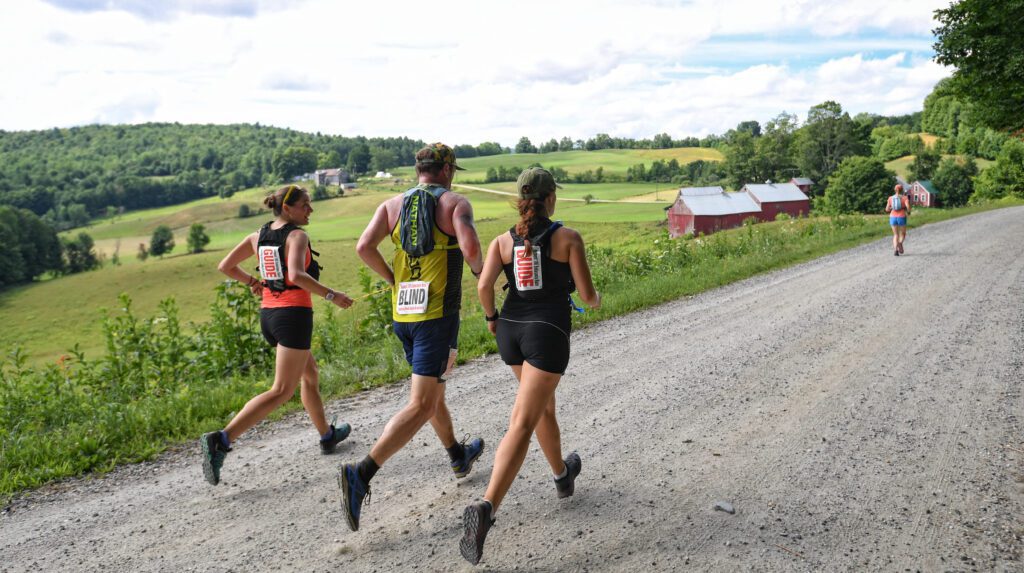By Max Huibregtse, Standard Correspondent
The Vermont 100 Endurance Race (VT100), a singular event in which runners compete alongside horseback riders in a 100-mile, three-day event, returns to the community this weekend.
Racers will set off from West Windsor at 4 a.m. on Saturday morning, and loop through Taftsville, Pomfret, Woodstock, Reading, and Cavendish before making their way back to the starting point in West Windsor at Silver Hill by 10 a.m. on Sunday.

Endurance runners and riders share the miles at the Vermont 100.
Ben Kimball Photo
The VT100 is unique as the only remaining race in the world where ultramarathon runners compete alongside endurance riders, simultaneously and on the same course. While these events used to be more common, most now hold their endurance ride and ultramarathon on separate weekends.
“It ends up being a bucket list race for a lot of people,” said race director Amy Rusiecki, because of its uniqueness and historic importance. It is also one of five 100-milers considered part of the American Grand Slam of Ultrarunning. Participants often feel that they are “running with history,” according to Rusiecki, alongside “the origins of this sport.”
The origins of ultramarathoning as a sport, as well as many, if not most, of its iconic races, are in equine endurance riding, the sport of horseback riders racing over several days on courses of 25 miles or more.
“A lot of the most iconic 100-milers across the country have that connection with endurance riding,” said Rusiecki, including the California-based Western States 100, often considered the birth of ultrarunning as a competitive sport, which was originally an endurance ride.

100 mile runners crest the “Sound of Music” hill on the Vermont 100 course. Ben Kimball Photo
The VT100 also has a claim to history as the spiritual successor of the first modern competitive endurance ride. While stunt endurance rides and long-distance races as publicity stunts had been common throughout the 19th and early 20th centuries, a challenge issued in 1911 by the Vermont-based Morgan Horse Club to the U.S. Army intended to prove that the club’s small horses were equal to or better than the larger ones favored by the military, leading to the first modern endurance ride in 1913, organized by Norwich University.
But perhaps the race’s most important innovation was, at the time, a groundbreaking concern for the welfare of the horses, which were often seriously injured or even killed by overexertion in previous endurance stunts. To prevent this, the race set up aid stations and also introduced maximum ride times and distances for a single day in order to prevent over-competitive riders from exhausting and injuring their horses.
The modern VT100 has no direct connection to these early races, instead growing out of tradition of casual endurance rides in the area in the 1960s. The modern endurance ride was founded in 1988, with the first footrace added in 1989.
One of the runners in that inaugural 100-mile run, and the race’s first director, was Laura Farrell, who had two years earlier founded Vermont Adaptive, a non-profit that “empowers people of all abilities through year-round inclusive sports and recreational programming regardless of their ability to pay,” according to its website.
“The charity and the event have been tied since inception,” said Rusiecki, and the event remains one of Vermont Adaptive’s largest annual fundraising events. Since 2015, the race has reserved spots for Team Run 2 Empower, the official fundraising team for Vermont Adaptive.
In 2017, the VT100 further committed to Vermont Adaptive’s mission by recognizing athletes with disabilities in their own award categories, with separate categories for athletes with both visual and mobility impairments. This year, seven athletes with disabilities are expected to compete in these categories.
“It’s starting to get a reputation with visually-impaired and mobility-impaired athletes across the country that it’s a race that they want to come and run because they feel so supported,” said Rusiecki, noting that the VT100 is the first ultramarathon to introduce a separate athletes with disabilities category.

Visually-impaired runners and their guides enjoy the Vermont 100.
Ben Kimball Photo
This year’s race is also its first year back after being washed out last year in the summer floods that devastated the area. With less than a week to go before the race, it had to be canceled; however, even this unfortunate turn of events had a silver lining.
“While it was devastating that the race was canceled last year, it was kind of a beautiful thing,” said Rusiecki, noting that “the community supports us” every year, and the floods became the race’s opportunity to give back. Many participants and volunteers “were already planning to come to Vermont,” according to Rusiecki, and so the race committee suddenly had “a bunch of people who would be willing to volunteer [and ask] ‘what can we do?’”
Over the next three days, several dozen people who had been planning to ride, run, or volunteer at the VT100 instead spent their time clearing out flooded basements and sanitizing contaminated front lawns. In addition, the two meals usually put on for the participants — a pre-race dinner and a post-race meal — were already prepared, and so were donated to displaced people in the area.
“All of the food that would have been serving us was serving the community,” said Rusiecki, a way for the race to return the favor of years of hoses, troughs, and aid stations set up for racers and horses on private land.
While the race committee had some concerns about the recent storms affecting the race again this year, “it hasn’t impacted our race course,” said Rusiecki, and the race will continue as normal, with about 450 runners and 50 riders expected this year.